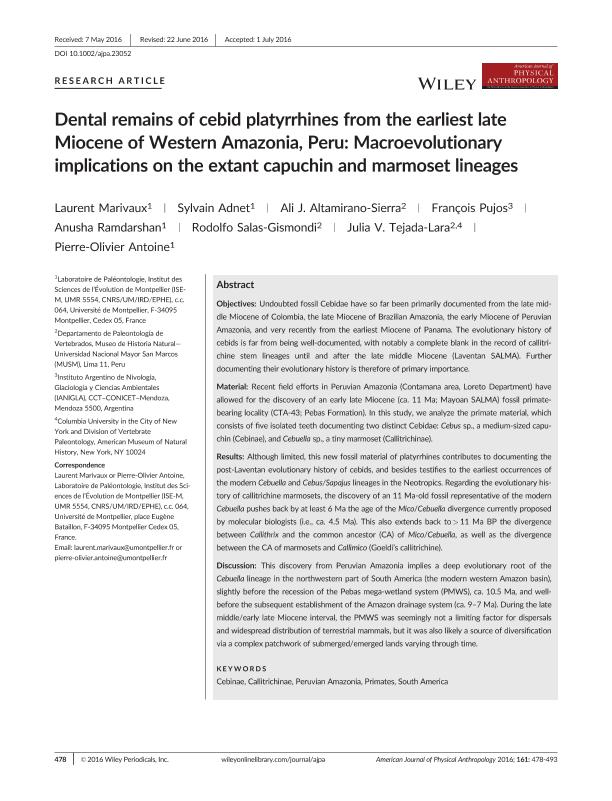Mostrar el registro sencillo del ítem
dc.contributor.author
Marivaux, Laurent

dc.contributor.author
Adnet, Sylvain
dc.contributor.author
Altamirano Sierra, Ali J.
dc.contributor.author
Pujos, François Roger Francis

dc.contributor.author
Ramdarshan, Anusha
dc.contributor.author
Salas Gismondi, Rodolfo
dc.contributor.author
Tejada Lara, Julia V.
dc.contributor.author
Antoine, Pierre Olivier

dc.date.available
2022-12-28T17:43:28Z
dc.date.issued
2016-07
dc.identifier.citation
Marivaux, Laurent; Adnet, Sylvain; Altamirano Sierra, Ali J.; Pujos, François Roger Francis; Ramdarshan, Anusha; et al.; Dental remains of cebid platyrrhines from the earliest late Miocene of Western Amazonia, Peru: Macroevolutionary implications on the extant capuchin and marmoset lineages; Wiley-liss, div John Wiley & Sons Inc.; American Journal Of Physical Anthropology; 161; 3; 7-2016; 478-493
dc.identifier.issn
0002-9483
dc.identifier.uri
http://hdl.handle.net/11336/182737
dc.description.abstract
Objectives: Undoubted fossil Cebidae have so far been primarily documented from the late middle Miocene of Colombia, the late Miocene of Brazilian Amazonia, the early Miocene of Peruvian Amazonia, and very recently from the earliest Miocene of Panama. The evolutionary history of cebids is far from being well-documented, with notably a complete blank in the record of callitrichine stem lineages until and after the late middle Miocene (Laventan SALMA). Further documenting their evolutionary history is therefore of primary importance. Material: Recent field efforts in Peruvian Amazonia (Contamana area, Loreto Department) have allowed for the discovery of an early late Miocene (ca. 11 Ma; Mayoan SALMA) fossil primate-bearing locality (CTA-43; Pebas Formation). In this study, we analyze the primate material, which consists of five isolated teeth documenting two distinct Cebidae: Cebus sp., a medium-sized capuchin (Cebinae), and Cebuella sp., a tiny marmoset (Callitrichinae). Results: Although limited, this new fossil material of platyrrhines contributes to documenting the post-Laventan evolutionary history of cebids, and besides testifies to the earliest occurrences of the modern Cebuella and Cebus/Sapajus lineages in the Neotropics. Regarding the evolutionary history of callitrichine marmosets, the discovery of an 11 Ma-old fossil representative of the modern Cebuella pushes back by at least 6 Ma the age of the Mico/Cebuella divergence currently proposed by molecular biologists (i.e., ca. 4.5 Ma). This also extends back to > 11 Ma BP the divergence between Callithrix and the common ancestor (CA) of Mico/Cebuella, as well as the divergence between the CA of marmosets and Callimico (Goeldi's callitrichine). Discussion: This discovery from Peruvian Amazonia implies a deep evolutionary root of the Cebuella lineage in the northwestern part of South America (the modern western Amazon basin), slightly before the recession of the Pebas mega-wetland system (PMWS), ca. 10.5 Ma, and well-before the subsequent establishment of the Amazon drainage system (ca. 9–7 Ma). During the late middle/early late Miocene interval, the PMWS was seemingly not a limiting factor for dispersals and widespread distribution of terrestrial mammals, but it was also likely a source of diversification via a complex patchwork of submerged/emerged lands varying through time.
dc.format
application/pdf
dc.language.iso
eng
dc.publisher
Wiley-liss, div John Wiley & Sons Inc.

dc.rights
info:eu-repo/semantics/openAccess
dc.rights.uri
https://creativecommons.org/licenses/by-nc-sa/2.5/ar/
dc.subject
CALLITRICHINAE
dc.subject
CEBINAE
dc.subject
PERUVIAN AMAZONIA
dc.subject
PRIMATES
dc.subject
SOUTH AMERICA
dc.subject.classification
Paleontología

dc.subject.classification
Ciencias de la Tierra y relacionadas con el Medio Ambiente

dc.subject.classification
CIENCIAS NATURALES Y EXACTAS

dc.title
Dental remains of cebid platyrrhines from the earliest late Miocene of Western Amazonia, Peru: Macroevolutionary implications on the extant capuchin and marmoset lineages
dc.type
info:eu-repo/semantics/article
dc.type
info:ar-repo/semantics/artículo
dc.type
info:eu-repo/semantics/publishedVersion
dc.date.updated
2022-12-27T18:15:42Z
dc.journal.volume
161
dc.journal.number
3
dc.journal.pagination
478-493
dc.journal.pais
Estados Unidos

dc.journal.ciudad
New York
dc.description.fil
Fil: Marivaux, Laurent. Université Montpellier II; Francia
dc.description.fil
Fil: Adnet, Sylvain. Université Montpellier II; Francia
dc.description.fil
Fil: Altamirano Sierra, Ali J.. Museo de Historia Natural, Lima; Perú
dc.description.fil
Fil: Pujos, François Roger Francis. Consejo Nacional de Investigaciones Científicas y Técnicas. Centro Científico Tecnológico Conicet - Mendoza. Instituto Argentino de Nivología, Glaciología y Ciencias Ambientales. Provincia de Mendoza. Instituto Argentino de Nivología, Glaciología y Ciencias Ambientales. Universidad Nacional de Cuyo. Instituto Argentino de Nivología, Glaciología y Ciencias Ambientales; Argentina
dc.description.fil
Fil: Ramdarshan, Anusha. Université Montpellier II; Francia
dc.description.fil
Fil: Salas Gismondi, Rodolfo. Museo de Historia Natural, Lima; Perú
dc.description.fil
Fil: Tejada Lara, Julia V.. Museo de Historia Natural, Lima; Perú
dc.description.fil
Fil: Antoine, Pierre Olivier. Université Montpellier II; Francia
dc.journal.title
American Journal Of Physical Anthropology

dc.relation.alternativeid
info:eu-repo/semantics/altIdentifier/url/https://onlinelibrary.wiley.com/doi/10.1002/ajpa.23052
dc.relation.alternativeid
info:eu-repo/semantics/altIdentifier/doi/http://dx.doi.org/10.1002/ajpa.23052
Archivos asociados
